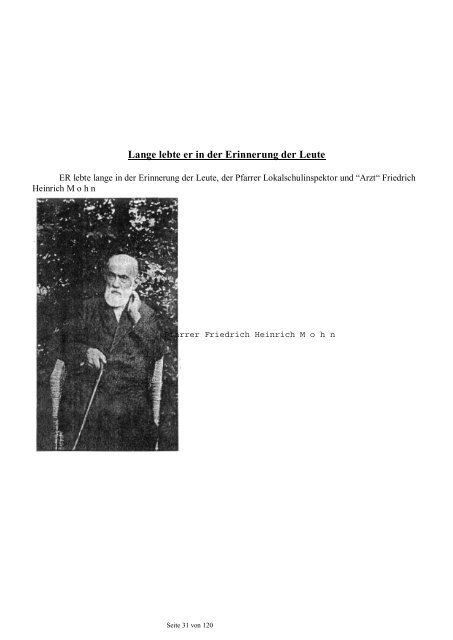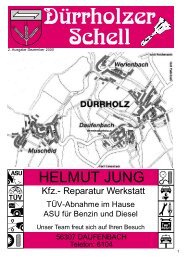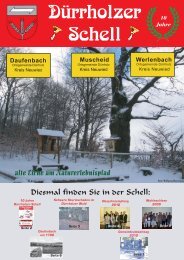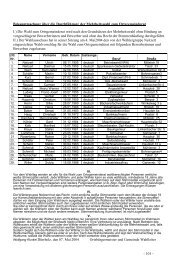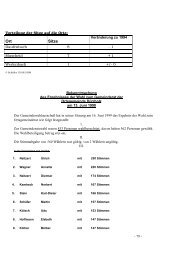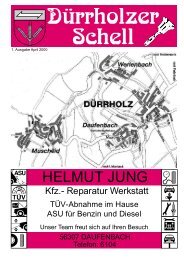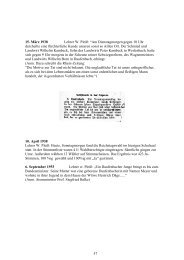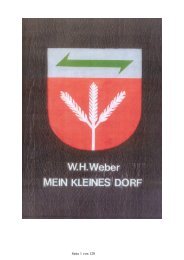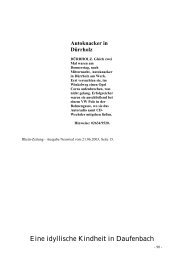Lange lebte er in der Erinnerung der Leute
Lange lebte er in der Erinnerung der Leute
Lange lebte er in der Erinnerung der Leute
Erfolgreiche ePaper selbst erstellen
Machen Sie aus Ihren PDF Publikationen ein blätterbares Flipbook mit unserer einzigartigen Google optimierten e-Paper Software.
<strong>Lange</strong> <strong>lebte</strong> <strong>er</strong> <strong>in</strong> d<strong>er</strong> Er<strong>in</strong>n<strong>er</strong>ung d<strong>er</strong> <strong>Leute</strong><br />
ER <strong>lebte</strong> lange <strong>in</strong> d<strong>er</strong> Er<strong>in</strong>n<strong>er</strong>ung d<strong>er</strong> <strong>Leute</strong>, d<strong>er</strong> Pfarr<strong>er</strong> Lokalschul<strong>in</strong>spektor und “Arzt“ Friedrich<br />
He<strong>in</strong>rich M o h n<br />
Pfarr<strong>er</strong> Friedrich He<strong>in</strong>rich M o h n<br />
Seite 31 von 120
Ev. Geme<strong>in</strong>dehaus <strong>in</strong> Pud<strong>er</strong>bach<br />
Seite 32 von 120
Er stammte aus Heiligenhaus, Bezirk Düsseldorf, und war Hilfspredig<strong>er</strong> <strong>in</strong> Neviges gewesen. Am<br />
12.4.1877 wurde <strong>er</strong> durch den Sup<strong>er</strong><strong>in</strong>tendenten Velten aus Neuwied <strong>in</strong> die ev. Geme<strong>in</strong>de zu Pud<strong>er</strong>bach<br />
e<strong>in</strong>geführt. Unt<strong>er</strong> den. B<strong>er</strong>icht von se<strong>in</strong><strong>er</strong> Ord<strong>in</strong>ation und E<strong>in</strong>führung schrieb <strong>er</strong> die Worte:<br />
“<strong>in</strong> fidem copiae“, d.h. “uns<strong>er</strong> V<strong>er</strong>mögen liegt im Glauben“. Im <strong>er</strong>sten Amtsjahr führte <strong>er</strong> die Traubibeln<br />
e<strong>in</strong>.<br />
Unt<strong>er</strong> vielen Würdigungen se<strong>in</strong><strong>er</strong> aufopf<strong>er</strong>ungsvollen Tätigkeit <strong>in</strong> d<strong>er</strong> Geme<strong>in</strong>de sei die als Erbau<strong>er</strong> d<strong>er</strong><br />
neuen ev. Kirche <strong>in</strong> Pud<strong>er</strong>bach vorangestellt.<br />
Die alte im 12. Jahrhund<strong>er</strong>t im romanischen Stil <strong>er</strong>baute Kirche wurde im Jahre 1885 polizeilich<br />
geschlossen, da sie als e<strong>in</strong>sturzdrohend begutachtet worden war.<br />
Pfr. Rudolf Löhr, Urbach, schreibt <strong>in</strong> se<strong>in</strong>em Biichle<strong>in</strong> "Wiedische Kirchengeschichte“: Hauptsorge war<br />
für die arme Geme<strong>in</strong>de die Aufbr<strong>in</strong>gung d<strong>er</strong> Bausumme für die neue Kirche <strong>in</strong> Pud<strong>er</strong>bach, und diese fiel<br />
besond<strong>er</strong>s auf den Pfarr<strong>er</strong>. Pfarr<strong>er</strong> Mohn hatte viele Gesuche schreiben müssen und auch manche<br />
Beihilfen von Staat und Kirche <strong>er</strong>halten. Ab<strong>er</strong> alles reichte nicht aus und die Lage zwang ihn, Reisen zu<br />
unt<strong>er</strong>nehmen bis nach Holland h<strong>in</strong>e<strong>in</strong>, um <strong>in</strong> aufreibend<strong>er</strong> Sammeltätigkeit die <strong>er</strong>ford<strong>er</strong>lichen Geld<strong>er</strong> zu<br />
beschaffen. Erst die Inflationszeit ab<strong>er</strong> hat die letzte Schuldenlast d<strong>er</strong> Geme<strong>in</strong>de abgenommen.<br />
Pfarr<strong>er</strong> Mohn sche<strong>in</strong>t <strong>in</strong> se<strong>in</strong><strong>er</strong> Heimat Heiligenhaus und Homb<strong>er</strong>g, Mettmann, Gruiten, Düssel, Wülfrath,<br />
Neviges, <strong>Lange</strong>nb<strong>er</strong>g und Velb<strong>er</strong>t gesammelt zu haben <strong>in</strong> Gottesdiensten, Vorträgen od<strong>er</strong> sonstigen<br />
Geme<strong>in</strong>dezusammenkünften. Oft war <strong>er</strong> v<strong>er</strong>mutlich üb<strong>er</strong> sechs Wochen aus d<strong>er</strong> Geme<strong>in</strong>de, um für die<br />
neue Kirche zu sammeln.<br />
Es wurde auch e<strong>in</strong> Gesuch an den Patron d<strong>er</strong> Geme<strong>in</strong>de, Se<strong>in</strong>e Durchlaucht den H<strong>er</strong>rn Fürsten zu Wied<br />
e<strong>in</strong>g<strong>er</strong>eicht um Bewilligung e<strong>in</strong>es jährlichen Gnadengeschenkes <strong>in</strong> d<strong>er</strong> Höhe d<strong>er</strong> wied<strong>er</strong> am Ost<strong>er</strong>fest zu<br />
tragenden Kirchensteu<strong>er</strong> statt dessen wurde von Sr. Durchlaucht 300 Mark “als e<strong>in</strong>malige Gabe“ bewilligt<br />
(spät<strong>er</strong> kamen jedoch noch 1000 Mark h<strong>in</strong>zu).<br />
Im Jahre 1881 wurde von hoh<strong>er</strong> kirchlich<strong>er</strong> Stelle die Genehmigung zu e<strong>in</strong><strong>er</strong> Hauskollekte <strong>in</strong> d<strong>er</strong><br />
Rhe<strong>in</strong>prov<strong>in</strong>z <strong>er</strong>teilt, bei d<strong>er</strong> e<strong>in</strong>e beträchtliche Summe gesammelt w<strong>er</strong>den konnte. Auch wurde e<strong>in</strong>e Bitte<br />
um Unt<strong>er</strong>stiitzung von 5.000 M. an den Hochwürdigsten Evangelischen Ob<strong>er</strong>kirchenrat <strong>in</strong> B<strong>er</strong>l<strong>in</strong><br />
g<strong>er</strong>ichtet.<br />
Seite 33 von 120
Die alte Kirche, l<strong>in</strong>ks das Lehr<strong>er</strong>haus, wahrsche<strong>in</strong>lich die <strong>er</strong>ste Schule<br />
<strong>in</strong> Pud<strong>er</strong>bach<br />
Seite 34 von 120<br />
Die neue Kirche<br />
E<strong>in</strong>weihung am 4.11.1887
Den Auftrag zum Bau d<strong>er</strong> neuen Kirche bekam d<strong>er</strong> Architekt August Hartel aus Leipzig, d<strong>er</strong> spät<strong>er</strong> als<br />
Dombaumeist<strong>er</strong> <strong>in</strong> Straßburg tätig war.<br />
Mitten <strong>in</strong> d<strong>er</strong> Bauzeit stirbt die Frau des Pfarr<strong>er</strong>s, Christiane Mohn, geb. H<strong>er</strong>zog, am 24.9.1886, zwei<br />
Tage vorh<strong>er</strong> ihr neugeborenes fünftes K<strong>in</strong>d Friedrich.<br />
Die Grundste<strong>in</strong>legung fand im selben Jahr (1886) statt. Dem Grundste<strong>in</strong> wurden Schriftstücke und<br />
Münzen beigefügt u.a. stiftete; Repräsentant H<strong>er</strong>b<strong>er</strong>t Kambeck aus Daufenbach e<strong>in</strong> 5 Mark-Stück <strong>in</strong><br />
Silb<strong>er</strong>.<br />
Die E<strong>in</strong>weihung d<strong>er</strong> neuen Kirche <strong>er</strong>folgte am 4.11.1887. E<strong>in</strong>geladen waren: Pfarr<strong>er</strong> d<strong>er</strong> Ob<strong>er</strong>en<br />
Grafschaft, die Bürg<strong>er</strong>meist<strong>er</strong> des Kirchspiels, d<strong>er</strong> Vorgäng<strong>er</strong> Pfr. Mohns, d<strong>er</strong> Pfr. Göbel, Sr. Durchlaucht<br />
und Kamm<strong>er</strong>direktor von Dung<strong>er</strong>n und die Wohltät<strong>er</strong><strong>in</strong> d<strong>er</strong> Geme<strong>in</strong>de Gräf<strong>in</strong> von d<strong>er</strong> Schulenburg. Im<br />
Hotel Kasche <strong>in</strong> Pud<strong>er</strong>bach wurde e<strong>in</strong> Essen für 2,50 Mark und 1/2 Flasche We<strong>in</strong> b<strong>er</strong>eitgestellt, den<br />
K<strong>in</strong>d<strong>er</strong>n e<strong>in</strong> Büchle<strong>in</strong> geschenkt.<br />
Kais<strong>er</strong> Fried<strong>er</strong>ich III. stiftete von San Remo den kle<strong>in</strong>en Abendmahlskelch “d<strong>er</strong> armen<br />
West<strong>er</strong>waldgeme<strong>in</strong>de Pud<strong>er</strong>bach“.<br />
Im Jahre 1901 wurde unt<strong>er</strong> Mitwirkung von Pfr. Mohn d<strong>er</strong> Posaunenv<strong>er</strong>e<strong>in</strong> Daufenbach gegründet..<br />
Im Jahre; 1904 gründete Pf r. Mohn e<strong>in</strong>en “Zweigv<strong>er</strong>e<strong>in</strong> d<strong>er</strong> Frauenhilfe“ und e<strong>in</strong>en “Jungfrauenv<strong>er</strong>e<strong>in</strong>“.<br />
Diesem Frauenv<strong>er</strong>e<strong>in</strong> wird von d<strong>er</strong> Kais<strong>er</strong><strong>in</strong> Auguste Viktoria <strong>in</strong> e<strong>in</strong><strong>er</strong> Urkunde mit e<strong>in</strong>em<br />
Begleitschreiben von Potsdam am 22.9.1906 offiziell bestätigt, daß <strong>er</strong> zum V<strong>er</strong>band d<strong>er</strong> Evangelischen<br />
Frauenhilfe <strong>in</strong> Deutschland gehört.<br />
Während d<strong>er</strong> Amtszeit Pfr. Mohns wurde unt<strong>er</strong> e<strong>in</strong>em Boten d<strong>er</strong> ev.. Gesellschaft mit dem Namen<br />
Johannes Loh e<strong>in</strong> gemischt<strong>er</strong> Chor <strong>in</strong> Daufenbach gegründet. (1887), dem man den ‘Namen “Eben Ez<strong>er</strong>“<br />
(Ste<strong>in</strong> d<strong>er</strong> Hilfe) gab. Ihm gehörte auch me<strong>in</strong>e Tante (Anna Rosenb<strong>er</strong>g) an. D<strong>er</strong> Dirigent war Lehr<strong>er</strong><br />
Schneid<strong>er</strong>, d<strong>er</strong> jedoch nach zwei Jahren se<strong>in</strong>en Dirigentenstab nied<strong>er</strong>legte. Dies geschah unt<strong>er</strong> dem Druck<br />
e<strong>in</strong>flussreich<strong>er</strong> <strong>Leute</strong>, die dem V<strong>er</strong>e<strong>in</strong> wegen se<strong>in</strong>es “christlichen Charakt<strong>er</strong>s“ nicht gut gesonnen waren.<br />
Im März 1899 gründete man <strong>in</strong> Daufenbach e<strong>in</strong>en neuen gemischten Chor unt<strong>er</strong> d<strong>er</strong> Leitung von Wilhelm<br />
Räd<strong>er</strong>. Dies<strong>er</strong> hatte die Begabung, obwohl <strong>er</strong> taub war, S<strong>in</strong>gstimmen wahrzunehmen und sie mit den<br />
e<strong>in</strong>zelnen Stimmlagen e<strong>in</strong>zuüben.<br />
Seite 35 von 120
D<strong>er</strong> gemichte Kirchenchor unt<strong>er</strong> Leitung<br />
von Lehr<strong>er</strong> B<strong>er</strong>nhard Krumm (1902-1904)<br />
An d<strong>er</strong> Drei Kirchspielsbuche <strong>in</strong> d<strong>er</strong> “Harschbach<strong>er</strong> Däll“ 1902<br />
v.l.n.r. vord<strong>er</strong>ste Reihe: Karl Bachenb<strong>er</strong>g, Wilh. Fritsch,<br />
Dorothea Oettgen, Luise Trepp<strong>er</strong>, Anna Velten, Lydia Bachenb<strong>er</strong>g, Kathar<strong>in</strong>a Baumann, Luise Schmidt..<br />
Mittl<strong>er</strong>e Reihe: Simon Räd<strong>er</strong>, Christ<strong>in</strong>e Mahl<strong>er</strong>t, Eleonore<br />
Kuhl, Anna R o s e n b e r g, Karl Neitz<strong>er</strong>t, Pfr. Mohn,<br />
Erw<strong>in</strong>e Mohn (Tocht<strong>er</strong>), Philipp<strong>in</strong>e Bachenb<strong>er</strong>g, Else Mohn.<br />
H<strong>in</strong>t<strong>er</strong>e Reihe: Jakob Dorr, Lehr<strong>er</strong> Krumm, Philipp Räd<strong>er</strong>,<br />
Karl Haag, Valent<strong>in</strong> Bachenb<strong>er</strong>g, Oskar ?‚ Karl Brabend<strong>er</strong>,<br />
Pet<strong>er</strong> Kraus, Simon Mahl<strong>er</strong>t, Pet<strong>er</strong> u. August Kraus.<br />
Im Jahre 1902 üb<strong>er</strong>nahm Lehr<strong>er</strong> Krumm die Leitung des Chores. Auf ihn folgte Karl Bachenb<strong>er</strong>g aus<br />
Daufenbach.<br />
Nach dem 1. Weltkrieg g<strong>in</strong>g d<strong>er</strong> Gottesdienstbesuch zurück. Pfr. Mohn soll auf d<strong>er</strong> Kanzel gewe<strong>in</strong>t haben<br />
mit d<strong>er</strong> Bem<strong>er</strong>kung, <strong>er</strong> habe die Kirche zu groß gebaut.<br />
Seite 36 von 120
Pfarr<strong>er</strong> Mohn war e<strong>in</strong> umsichtig<strong>er</strong>, gütig<strong>er</strong> und zugleich streng<strong>er</strong> Seelsorg<strong>er</strong>, dessen Geme<strong>in</strong>de aus vielen<br />
Dörf<strong>er</strong>n bestand: Pud<strong>er</strong>bach, Daufenbach, Muscheid, W<strong>er</strong>lenbach ‚ Bauscheid, Breitscheid, Döttesfeld,<br />
0b<strong>er</strong>ähren, Reichenste<strong>in</strong>, Hab<strong>er</strong>scheid, Strunkeich, Rich<strong>er</strong>t, W<strong>er</strong>oth, Wold<strong>er</strong>t und Nied<strong>er</strong>dreis. Se<strong>in</strong>e<br />
weiten Fußmärsche zu den Kranken, denen <strong>er</strong> durch Homöopathie half, mit d<strong>er</strong> B<strong>er</strong>gmannslampe <strong>in</strong> d<strong>er</strong><br />
wacht, s<strong>in</strong>d bis heute unv<strong>er</strong>gessen. Unv<strong>er</strong>gessen s<strong>in</strong>d ab<strong>er</strong> auch se<strong>in</strong>e Aufopf<strong>er</strong>ung und Liebe, die <strong>er</strong> als<br />
Vorsitzend<strong>er</strong> des Kuratoriums d<strong>er</strong> Erziehungsanstalt Ob<strong>er</strong>bieb<strong>er</strong> <strong>in</strong> schw<strong>er</strong>en Jahren zugewandt hatte.<br />
Auch d<strong>er</strong> Ehrenste<strong>in</strong>, d<strong>er</strong> den E<strong>in</strong>gang zum Friedhof <strong>in</strong> Pud<strong>er</strong>bach schmückt, ist Ffr. Mohns W<strong>er</strong>k Das<br />
Denkmal <strong>er</strong>richteten die zum Zweckv<strong>er</strong>band "Heimatdank" zusammengeschlossenen V<strong>er</strong>e<strong>in</strong>e aus eigen<strong>er</strong><br />
Kraft ihren gefallenen Brüd<strong>er</strong>n. Die fei<strong>er</strong>liche E<strong>in</strong>weihung fand am 9.11. 1924 unt<strong>er</strong> d<strong>er</strong> Beteiligung d<strong>er</strong><br />
ganzen Geme<strong>in</strong>de statt.<br />
Pfarr<strong>er</strong> Mohn - das war d<strong>er</strong> Name, d<strong>er</strong> mir aus me<strong>in</strong><strong>er</strong> K<strong>in</strong>dheit <strong>in</strong> Er<strong>in</strong>n<strong>er</strong>ung geblieben ist, denn Mutt<strong>er</strong><br />
nannte ihn oft.<br />
Mutt<strong>er</strong>s Schulentlassungszeugnis trägt se<strong>in</strong>en Namen als Schulaufsichtsbeamt<strong>er</strong>, und auf ihrem<br />
“Konfirmationszeugnis“ stehen unt<strong>er</strong> dem Bibelspruch die Worte: De<strong>in</strong> getreu<strong>er</strong> Lehr<strong>er</strong> und. Seelsorg<strong>er</strong><br />
F. Mohn, Pfr.<br />
In d<strong>er</strong> “Wiedischen Kirchengeschichte“ heißt es: “Pfarr<strong>er</strong> Mohn, dessen Gestalt <strong>in</strong> lebendig<strong>er</strong> Er<strong>in</strong>n<strong>er</strong>ung<br />
ist, war e<strong>in</strong> fleißig<strong>er</strong> und. treu<strong>er</strong> Pfarr<strong>er</strong>. Unablässig trieb ihn Pflicht und Aufopf<strong>er</strong>ung für das Leib-und<br />
Seelenwohl se<strong>in</strong><strong>er</strong> Geme<strong>in</strong>deglied<strong>er</strong>, und besond<strong>er</strong>s <strong>in</strong> d<strong>er</strong> schw<strong>er</strong>en Influenza—Epidemie 1892/93 hat‘ <strong>er</strong><br />
als Arzt und Helf<strong>er</strong> selbstlos unv<strong>er</strong>gessene Dienste getan... Neben d<strong>er</strong> Kirche ist Pfarr<strong>er</strong> Mohn das Geme<strong>in</strong>dehaus<br />
zu danken, das im Jahre 1911 entstand. Viele Geschenke von Freunden <strong>in</strong> d<strong>er</strong> F<strong>er</strong>ne halfen es<br />
schmücken, und se<strong>in</strong>e Fenst<strong>er</strong> stammen aus e<strong>in</strong>em Patrizi<strong>er</strong>haus <strong>in</strong> Elb<strong>er</strong>feld... Die Synode Wied b<strong>er</strong>ief<br />
ihn zum Sup<strong>er</strong><strong>in</strong>tendenten. Er war zudem Vorsitzend<strong>er</strong> des Kuratoriums d<strong>er</strong> Erziehungsanstalt Ob<strong>er</strong>bieb<strong>er</strong>...<br />
Nach kurzem Fei<strong>er</strong>abend, den <strong>er</strong> <strong>in</strong> se<strong>in</strong><strong>er</strong> ihm ans H<strong>er</strong>z gewachsenen Geme<strong>in</strong>de v<strong>er</strong><strong>lebte</strong>, g<strong>in</strong>g <strong>er</strong><br />
im Novemb<strong>er</strong> 1926 heim und fand. ‚auf uns<strong>er</strong>em Friedhof se<strong>in</strong>e Ruhestätte.“<br />
Me<strong>in</strong> Brud<strong>er</strong> Walt<strong>er</strong> – e<strong>in</strong> Unglücksrabe<br />
WIE b<strong>er</strong>eits <strong>er</strong>wähnt, besuchten Walt<strong>er</strong>, Brunhilde und ich jeweils e<strong>in</strong> halbes Jahr die Schule <strong>in</strong><br />
me<strong>in</strong>em kle<strong>in</strong>en Dorf. Für Großmutt<strong>er</strong> muss es e<strong>in</strong>e sehr aufregende und anstrengende Zeit gewesen se<strong>in</strong>,<br />
als sie me<strong>in</strong>en Brud<strong>er</strong> Walt<strong>er</strong> bei sich hatte. Nicht Augen genug hatte sie für ihren lebhaften Enkel.<br />
E<strong>in</strong>mal hatte <strong>er</strong> sich h<strong>in</strong>t<strong>er</strong> e<strong>in</strong>en Jauchewagen gestellt und den Hahn am Paß geöffnet, so daß sich die<br />
Jauche üb<strong>er</strong> ihn <strong>er</strong>goss. E<strong>in</strong> and<strong>er</strong>es Mal landete <strong>er</strong> mit e<strong>in</strong>em Leit<strong>er</strong>wagen <strong>in</strong> e<strong>in</strong><strong>er</strong> Menge Brennnesseln.<br />
Se<strong>in</strong>e Haut war danach mit Quaddeln bedeckt, die sehr juckten und brannten.<br />
In d<strong>er</strong> Blüte se<strong>in</strong>es Lebens stehend, musste <strong>er</strong> bei e<strong>in</strong>em Flugzeugabsturz im Zweiten Weltkrieg diese<br />
Welt für imm<strong>er</strong> v<strong>er</strong>lassen. An dies<strong>er</strong> Stelle muss ich wied<strong>er</strong> <strong>in</strong> schm<strong>er</strong>zlich<strong>er</strong> Er<strong>in</strong>n<strong>er</strong>ung an ihn denken...<br />
Großmutt<strong>er</strong> zieht <strong>in</strong> den 1. Stock<br />
GROßMUTTER und ihre unv<strong>er</strong>heiratete Tocht<strong>er</strong>, me<strong>in</strong>e Tante Anna, führten noch fünf Jahre nach<br />
Großvat<strong>er</strong>s Tod den landwirtschaftlichen Betrieb. Als diese dann heiratete, v<strong>er</strong>kaufte Großmutt<strong>er</strong> Vieh<br />
und G<strong>er</strong>ät und v<strong>er</strong>pachtete Feld<strong>er</strong> und. Wiesen. Sie zog <strong>in</strong> den <strong>er</strong>sten Stock ihres Hauses, und danach<br />
Seite 37 von 120
Lehr<strong>er</strong> Walt<strong>er</strong> Pleis mit Schül<strong>er</strong> und Schül<strong>er</strong><strong>in</strong>nen d<strong>er</strong> e<strong>in</strong>klassigen Volksschule<br />
Und e<strong>in</strong>igen K<strong>in</strong>d<strong>er</strong>n im Vorschulalt<strong>er</strong>.<br />
Me<strong>in</strong> Brud<strong>er</strong> Walt<strong>er</strong> e<strong>in</strong> elfjährig<strong>er</strong> <strong>in</strong> d<strong>er</strong> ob<strong>er</strong>sten reihe d<strong>er</strong> 2. v.l. (x)<br />
Daufenbach 1929<br />
v<strong>er</strong>mietete sie die Wohnung im Erdgeschoß. Jetzt hatte sie Zeit für sich, konnte Besuch<br />
empfangen und selbst auf Besuch gehen. Oft kam d<strong>er</strong> Besuch unangemeldet. Dann gab sie<br />
sich fl<strong>in</strong>k daran, dem Gast od<strong>er</strong> den Gästen etwas auf den Tisch zu br<strong>in</strong>gen. Im Nu hatte sie<br />
die R<strong>in</strong>ge von d<strong>er</strong> H<strong>er</strong>dfeu<strong>er</strong>stelle genommen, Holzstücke auf das nied<strong>er</strong>gebrannte Feu<strong>er</strong><br />
gelegt und Kaffeewass<strong>er</strong> im Flötenkessel aufgesetzt. Die Kaffeebohnen mahlte sie von<br />
Hand <strong>in</strong> d<strong>er</strong> Kaffeemühle. Manchmal buk sie auch Waffeln. Sie setzte Weißbrot, Butt<strong>er</strong><br />
und. selbstgemachtes Gelee od<strong>er</strong> auch Sch<strong>in</strong>ken und Wurst auf den Tisch, üb<strong>er</strong> dem im<br />
Somm<strong>er</strong> d<strong>er</strong> unentbehrliche Fliegenfäng<strong>er</strong> h<strong>in</strong>g.<br />
Oft kam ihre Nichte, uns<strong>er</strong>e “Goot“, zu Besuch, die unv<strong>er</strong>heiratet war. Als K<strong>in</strong>d hatte sie<br />
e<strong>in</strong>en schw<strong>er</strong>en Unfall gehabt: Beim Bedienen d<strong>er</strong> Häckselmasch<strong>in</strong>e war ihre rechte Hand<br />
<strong>in</strong> die scharfen Mess<strong>er</strong> gekommen, die das Stroh <strong>in</strong> kle<strong>in</strong>e Stücke schnitten. Fortan hatte sie<br />
e<strong>in</strong>en Armstumpf, ab<strong>er</strong> mit den Jahren brachte sie es zu <strong>er</strong>staunlichen F<strong>er</strong>tigkeiten. Ich kann<br />
mich noch gut an sie <strong>er</strong><strong>in</strong>n<strong>er</strong>n. Meistens sah man sie mit Strickarbeiten beschäftigt; sie war<br />
imm<strong>er</strong> gut<strong>er</strong> Laune und hatte viel Humor.<br />
Seite 38 von 120
Von d<strong>er</strong> Buchb<strong>in</strong>d<strong>er</strong>ei angetan<br />
ANFANG d<strong>er</strong> dreißig<strong>er</strong> Jahre zog e<strong>in</strong>e Familie Dills <strong>in</strong>s Haus; sie gehörte auch d<strong>er</strong><br />
freikirchlichen Geme<strong>in</strong>de an. Pet<strong>er</strong> Dills war gel<strong>er</strong>nt<strong>er</strong> Buchb<strong>in</strong>d<strong>er</strong> und hatte <strong>in</strong> Neuwied<br />
das Geschäft und die W<strong>er</strong>kstatt. Jeden Morgen fuhr <strong>er</strong> mit se<strong>in</strong>em Ford-Kastenwagen <strong>in</strong> die<br />
Kreisstadt. Er betrieb gleichzeitig e<strong>in</strong> Fahrunt<strong>er</strong>nehmen‘(<strong>in</strong> dem Kastenwagen waren Bänke<br />
aufgestellt, die d<strong>er</strong> P<strong>er</strong>sonenbeförd<strong>er</strong>ung dienten). Männ<strong>er</strong> aus me<strong>in</strong>em kle<strong>in</strong>en Dorf und<br />
aus Nachbardörf<strong>er</strong>n benutzten dieses Beförd<strong>er</strong>ungsmittel, um sich zur Arbeit <strong>in</strong> die<br />
Kreisstadt od<strong>er</strong> zum “Rasselste<strong>in</strong>“ (Blechwalzw<strong>er</strong>k) br<strong>in</strong>gen zu lassen.<br />
Als Gymnasiast -<strong>in</strong> den Schulf<strong>er</strong>ien - fuhr ich des Öft<strong>er</strong>en mit ihm nach Neuwied. D<strong>er</strong><br />
große Wagen mit dem kle<strong>in</strong>en Motorgehäuse stand <strong>in</strong> uns<strong>er</strong><strong>er</strong> Scheune, und morgens <strong>in</strong><br />
all<strong>er</strong> Frühe entließ die zweckentfremdete Scheune das Gefährt.<br />
In se<strong>in</strong><strong>er</strong> W<strong>er</strong>kstatt sah ich dem Buchb<strong>in</strong>d<strong>er</strong> g<strong>er</strong>n bei d<strong>er</strong> Arbeit zu, wie <strong>er</strong> mit<br />
künstl<strong>er</strong>ischem Geschick und Talent Buchrücken beschriftete, Blattgold v<strong>er</strong>arbeitete, die<br />
Prägepresse bediente, mit d<strong>er</strong> Pappsch<strong>er</strong>e hanti<strong>er</strong>te und Rückenleimungen sowie Heftungen<br />
und Ausbess<strong>er</strong>ungen an Büch<strong>er</strong>n, Heften und Broschüren vornahm. Von se<strong>in</strong><strong>er</strong> Tätigkeit<br />
war ich noch mehr fasz<strong>in</strong>i<strong>er</strong>t als von d<strong>er</strong> des Wagn<strong>er</strong>meist<strong>er</strong>s <strong>in</strong> me<strong>in</strong>em kle<strong>in</strong>en Dorf.<br />
Auch hi<strong>er</strong> fiel für mich so e<strong>in</strong>iges ab, was beim Buchb<strong>in</strong>den übrig blieb: Pappe, Goldpapi<strong>er</strong>,<br />
Led<strong>er</strong>- und Le<strong>in</strong>enreste. E<strong>in</strong>mal blieb ich üb<strong>er</strong> Nacht <strong>in</strong> d<strong>er</strong> W<strong>er</strong>kstatt natürlich mit<br />
E<strong>in</strong>v<strong>er</strong>ständnis d<strong>er</strong> Me<strong>in</strong>en) und machte mir auf dem harten Arbeitstisch e<strong>in</strong> Lag<strong>er</strong> zum<br />
Schlafen zurecht.<br />
D<strong>er</strong> Grund: In d<strong>er</strong> Z<strong>in</strong>zendorf-Schule d<strong>er</strong> H<strong>er</strong>rnhut<strong>er</strong> Brüd<strong>er</strong>geme<strong>in</strong>e fand e<strong>in</strong>e Hochzeit<br />
statt. Die Braut war e<strong>in</strong>e Kus<strong>in</strong>e zweiten Grades von mir, und me<strong>in</strong>e kurzfristig getroffene<br />
Entscheidung, an d<strong>er</strong> Festlichkeit teilzunehmen, <strong>er</strong>schw<strong>er</strong>te die B<strong>er</strong>eitstellung e<strong>in</strong>es<br />
Quarti<strong>er</strong>s.<br />
E<strong>in</strong> gew<strong>er</strong>blich<strong>er</strong> Betrieb im Wirtschaftsgebäude<br />
IN den dreißig<strong>er</strong> Jahren etabli<strong>er</strong>te sich e<strong>in</strong>e Rasi<strong>er</strong>kl<strong>in</strong>gen-Schleif<strong>er</strong>ei <strong>in</strong> uns<strong>er</strong>em<br />
Wirtschaftsgebäude. Im Stall, <strong>in</strong> dem schon seit vielen Jahren ke<strong>in</strong> Vieh mehr<br />
unt<strong>er</strong>gebracht war (an se<strong>in</strong>e früh<strong>er</strong>e Funktion <strong>er</strong><strong>in</strong>n<strong>er</strong>ten nur noch die Futt<strong>er</strong>krippen),<br />
wurden Arbeitsplätze für die Familienmitglied<strong>er</strong> des Unt<strong>er</strong>nehm<strong>er</strong>s sowie für die<br />
e<strong>in</strong>heimischen Arbeit<strong>er</strong> geschaffen. Spät<strong>er</strong> zog d<strong>er</strong> Karl Furtmann, so hieß d<strong>er</strong> Eigentüm<strong>er</strong><br />
des kle<strong>in</strong>en Betriebes, <strong>in</strong> e<strong>in</strong> neu <strong>er</strong>richtetes W<strong>er</strong>kstattgebäude um.<br />
E<strong>in</strong>käufe im Dorf<br />
GROßMUTTER musste nun schon viele Jahre ihre Lebensmittel im Dorf e<strong>in</strong>kaufen.<br />
Wenn wir K<strong>in</strong>d<strong>er</strong> da waren, halfen wir ihr natürlich, so gut es g<strong>in</strong>g, beim E<strong>in</strong>kaufen. Nach<br />
dem Mittagessen zog ich mit d<strong>er</strong> weißen Emaillekanne zu “Fritz-Henrichs“, um Milch zu<br />
holen. Manchmal musste ich im Stall warten, weil noch gemolken wurde. Wenn ich <strong>in</strong> d<strong>er</strong><br />
Küche auf die Milch wartete, saß ich d<strong>er</strong> alten Oma gegenüb<strong>er</strong>, die auf dem Kopf e<strong>in</strong><br />
Spitzenhäubchen trug.<br />
Seite 39 von 120
Die jüdische Familie Cahn<br />
NACH d<strong>er</strong> Macht<strong>er</strong>greifung durch Hitl<strong>er</strong> gab es auch <strong>in</strong> me<strong>in</strong>em kle<strong>in</strong>en Dorf e<strong>in</strong>ige<br />
V<strong>er</strong>blendete und braune Fanatik<strong>er</strong>. Das zeigte sich ganz besond<strong>er</strong>s <strong>in</strong> d<strong>er</strong><br />
“Reichskristallnacht“ 1938: Am Rande des Dorfes wohnte e<strong>in</strong>e jüdische Familie; ihr Heim<br />
glich eh<strong>er</strong> e<strong>in</strong><strong>er</strong> Hütte als e<strong>in</strong>em Wohnhaus (d<strong>er</strong> Fußboden war noch aus Lehm). Die<br />
Familie bestand aus dem Vat<strong>er</strong> Max Cahn, d<strong>er</strong> Mutt<strong>er</strong> Jettchen, den K<strong>in</strong>d<strong>er</strong>n Joseph,<br />
Günth<strong>er</strong> und G<strong>er</strong>da. Vat<strong>er</strong> Cahn handelte mit Lämm<strong>er</strong>n und v<strong>er</strong>kaufte auch Lammfleisch.<br />
In d<strong>er</strong> “Reichskristallnacht“ wurde ihnen übel mitgespielt: Fanatik<strong>er</strong> z<strong>er</strong>schlugen ihnen<br />
Mobiliar und Geschirr und d<strong>er</strong> Frau das bisschen E<strong>in</strong>gemachte, das sie für ihre Familie<br />
aufbewahrt hatte.<br />
Gisela P. <strong>er</strong>zählte mir, daß sie mit dem “Maxen-Jupp“ oft Ziegen gehütet habe. Und als das<br />
Haus längst nicht mehr bewohnt war, habe sie geme<strong>in</strong>sam mit and<strong>er</strong>en Mädchen und<br />
Jungen das Dach abdecken helfen. Freundlich und hilfsb<strong>er</strong>eit seien sie imm<strong>er</strong> gewesen, die<br />
Cahns. W<strong>er</strong> zum Beispiel vom Regen üb<strong>er</strong>rascht wurde, fand bei ihnen E<strong>in</strong>laß od<strong>er</strong> bekam<br />
e<strong>in</strong>en Schirm mit auf den Weg,<br />
WÄHREND des Zweiten Weltkrieges war ich ganz selten, und. dann nur zu e<strong>in</strong>em<br />
kurzen Besuch <strong>in</strong> me<strong>in</strong>em kle<strong>in</strong>en Dorf. In jen<strong>er</strong> Zeit hatten selbst die kle<strong>in</strong>sten Bau<strong>er</strong>n<br />
genügend Naturalien, um die sie die Stadtmenschen beneideten. Bekanntlich nutzten viele<br />
Bau<strong>er</strong>n die Notlage d<strong>er</strong> Menschen <strong>in</strong> den z<strong>er</strong>bombten Städten weidlich aus. Großmutt<strong>er</strong>, die<br />
imm<strong>er</strong> e<strong>in</strong> gastliches Haus führte, musste am eigenen Leib <strong>er</strong>fahren, wie bitt<strong>er</strong> es war, um<br />
e<strong>in</strong>en Lit<strong>er</strong> Milch od<strong>er</strong> um e<strong>in</strong> paar Ei<strong>er</strong> zu “betteln“.<br />
MEINE unv<strong>er</strong>gessliche Großmutt<strong>er</strong> starb, fast 95 jährig, im Jahre 1954. Das Haus<br />
wurde an e<strong>in</strong> Flüchtl<strong>in</strong>gsehepaar v<strong>er</strong>kauft.<br />
E<strong>in</strong> früh<strong>er</strong><strong>er</strong> Dorfbewohn<strong>er</strong> wird Bundesm<strong>in</strong>ist<strong>er</strong><br />
MEIN kle<strong>in</strong>es Dorf konnte e<strong>in</strong>ige Jahre e<strong>in</strong>e Familie zu se<strong>in</strong>en Bewohn<strong>er</strong>n zählen,<br />
aus d<strong>er</strong> e<strong>in</strong> Mitglied h<strong>er</strong>vorg<strong>in</strong>g, das spät<strong>er</strong> sehr prom<strong>in</strong>ent wurde. Als im Jahre 1960 Fei<strong>er</strong>lichkeiten<br />
zum 100 jährigen Jubiläum d<strong>er</strong> Schulgeme<strong>in</strong>den stattfanden, nahm d<strong>er</strong> zur Zeit<br />
amti<strong>er</strong>ende Bundesm<strong>in</strong>ist<strong>er</strong> für Atomen<strong>er</strong>gie und. Wass<strong>er</strong>wirtschaft, Professor Siegfried<br />
Balke, daran teil. Er hatte se<strong>in</strong>e <strong>er</strong>sten beiden Schuljahre (1908— 1910) <strong>in</strong> Daufenbach<br />
absolvi<strong>er</strong>t.<br />
In dem Buch “Bonn<strong>er</strong> Köpfe“ ist folgendes zu lesen: “Siegfried Balke wurde am 1. Juni<br />
1902 <strong>in</strong> Bochum als ältest<strong>er</strong> von vi<strong>er</strong> Söhnen geboren. Se<strong>in</strong> Vat<strong>er</strong> war Schneid<strong>er</strong>meist<strong>er</strong>,<br />
se<strong>in</strong>e Mutt<strong>er</strong>, die aus dem armen West<strong>er</strong>wald stammte, Hausangestellte <strong>in</strong> Düsseldorf. Die<br />
frühe Gewöhnung an Entbehrungen war im West<strong>er</strong>wald, woh<strong>in</strong> die Elt<strong>er</strong>n bald nach ihr<strong>er</strong><br />
Seite 41 von 120
Heirat <strong>in</strong> das Dörfchen Daufenbach v<strong>er</strong>zogen, nichts besond<strong>er</strong>es. Hi<strong>er</strong> l<strong>er</strong>nte <strong>er</strong> das Melken<br />
d<strong>er</strong> Ziegen und das Dengeln d<strong>er</strong> Sense. Spät<strong>er</strong> üb<strong>er</strong>siedelten sie nach Ehrenbreitste<strong>in</strong> bei<br />
Koblenz.<br />
Die Entbehrungen waren weitgehend se<strong>in</strong>e Erzieh<strong>er</strong>. Er hat e<strong>in</strong> gutes Gedächtnis, von dem<br />
<strong>er</strong> Proben gibt, wenn <strong>er</strong> üb<strong>er</strong> K<strong>in</strong>dheit und Jugend <strong>er</strong>zählt. Die strenge, etwas simple<br />
Pädagogik d<strong>er</strong> Volksschule des West<strong>er</strong>walddorfes hat es ihm angetan; was <strong>er</strong> dort l<strong>er</strong>nte,<br />
behalte <strong>er</strong> bis ans Lebensende. Lehr<strong>er</strong> und Pfarr<strong>er</strong> brachten ihn auf die höh<strong>er</strong>e Schule...<br />
HIER <strong>er</strong>schöpfen sich me<strong>in</strong>e K<strong>in</strong>dheits<strong>er</strong><strong>in</strong>n<strong>er</strong>ungen, sowie die d<strong>er</strong> Jugendzeit.<br />
Me<strong>in</strong> kle<strong>in</strong>es Dorf ist and<strong>er</strong>s geworden! Obwohl es hi<strong>er</strong> noch ke<strong>in</strong>en Tourismus gibt, braust<br />
d<strong>er</strong> motorisi<strong>er</strong>te V<strong>er</strong>kehr durch das e<strong>in</strong>stmals stille Dorf. Es gibt mod<strong>er</strong>ne Häus<strong>er</strong>,<br />
Bungalows, wo früh<strong>er</strong> Bau<strong>er</strong>nhöfe standen. Die Alten leben nicht mehr, die Gleichaltrigen<br />
s<strong>in</strong>d z.T. gefallen, v<strong>er</strong>zogen od<strong>er</strong> auch schon gestorben.<br />
Mit Wehmut - ab<strong>er</strong> auch mit Dankbarkeit - denke ich an me<strong>in</strong> K<strong>in</strong>dheitsparadies zurück-.<br />
Me<strong>in</strong> kle<strong>in</strong>es Dorf - es ist mir fremd geworden!<br />
Aachen, im Jahre 1983<br />
Seite 42 von 120


